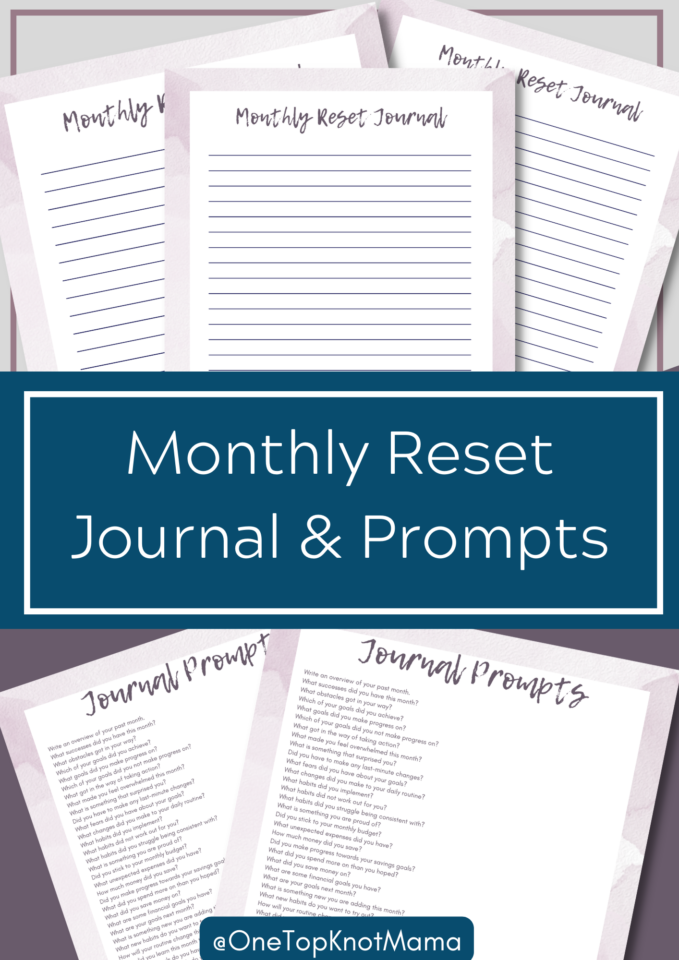Disclosure: If you click one of my shoppable links, I may earn a small commission, at no additional cost to you. I appreciate when you use my links to shop!
It’s back to school season, and it reminds me of new beginnings, a new year, a fresh start. People are far beyond only setting goals and taking a look at the trajectory of their life in the New Year, or even each quarter of the year. Monthly resets have become very popular as they allow you to take a look back at the past month, look at your successes and goals you have achieved, and reflect on what you want to work on for the next month.
Combined with weekly resets every Sunday (or whenever your workweek begins), you can start having a happy, balanced, and productive life.
Keep reading for a FREE Monthly Reset Journal and Prompt Questions you can download and start using TODAY!

What is a Monthly Reset?
Resets are a powerful and impactful way to reflect on your life, make plans, and set goals. It is also a great time to schedule appointments, do some self-care, and clean and organize your home and workspace before a new month begins.
With a monthly reset, you are going through 3 basic stages:
- Journaling and reflection of the recent or current month.
- Tasks that help you set yourself up for a healthy, happy, productive month.
- Setting goals for the next month.
Monthly resets are a great time to look at the goals you have set, and reflect on them, set new goals for the next month, and go through some monthly tasks that you would like to get done before the next month begins.
Keep reading to find out what the 7 most important tasks are for your monthly reset.

1. Journal a Brain Dump About Your Month
Before reflecting on this past month and looking at what you accomplished (and need to work on), it helps to first start with a brain dump. The brain dump allows you to get all of those many thoughts and feelings out of your head and onto paper.
Many times, our thoughts are circling around each other, and it feels like trying to find our way through a maze just to single one out. This is very common and happens to everyone. But with a brain dump, you are able to write out each thought pattern, emotion, and feeling, and start making sense of that maze of thoughts and ideas.
How to Do a Brain Dump?
Just write! It’s that simple. This is the easiest form of journaling, since you don’t have to focus on a specific topic, or even think about what you are trying to accomplish with the journal entry. All you are doing is writing whatever comes to your mind, at whatever speed and order.
You don’t need to write a story that makes sense, and you should never worry about jumping from one topic to the next. That is encouraged!
Get out a journal, notebook, or piece of paper, and just start a stream of consciousness page where you write whatever is on your mind. You might notice that it starts slow, but picks up as you think of more and more thoughts and ideas you want to unpack.
How Much to Write?
The great thing about brain dumps is there are no rules, including how much you should be writing. It might be half a page, or more than 5 pages. It really depends how much you have on your mind right now, and what you are trying to work through in your thoughts.
If it helps, you can try to focus on thoughts about the past month and what you want to get done, but don’t feel pressured to write about just one thing. The objective here is to just make sense of your current thoughts, pull out any important ideas or feelings you have, and gain some clarity about what is going on in your life right now.
2. Reflect on the Past Month
Once you have done your brain dump, it is then time for reflecting on the past month. This is a big part of the monthly reset, as it helps you to understand the progress you made, what challenges or obstacles you experienced, what you are grateful for, and what you want to work on for the next month.
Here are some questions to answer that will help you to do past month reflection:
What are you proud of?
What was something challenging?
What obstacle kept you from achieving your goals?
What goals did you have for this past month?
What goals did you accomplish?
What are you grateful for?
What do you want to change next month?
If you are brand new to monthly resets, you might not have a detailed list of what you wanted to accomplish in the previous month, and that’s okay! Just write about the month you had, what is inspiring you to start working on resets for each month, and what new ideas or thoughts you had recently.
See Also:
3. Set Goals for the Next Month
Now we are going to set some goals for the next month. These are your basic goals or anything you are hoping to accomplish. Remember that you only have one month to focus on them, so it shouldn’t be something that is impossible to reach.
The number of goals you have is completely up to you, but think about the different areas of your life. For example, you might have:
- Health and fitness goals
- Work and business goals
- Budget and financial goals
- Housework and organizing goals
- Personal life goals
Go through each area of your life and think about what you really want to get done. This is not when you think about errands to run or appointments you have – that comes later. For now, just think about 3-5 main things you want to do this month.
For example, if you are currently on a new fitness journey, you might set a new goal for the month about doing a specific workout program consistently throughout the month. If you have a YouTube channel for your business, maybe you want to do one new video every week for the month, or you have a subscriber count goal you want to reach in a month.
Keep reading for a FREE Monthly Reset Journal and Prompt Questions you can download and start using TODAY!
4. Review Your Budget and Finance Goals
Now let’s get to the other tasks you might want to get done before a new month begins. A really good habit to add to your monthly reset routine is reviewing your budget and finances, and setting some new goals for the month.
It is a good idea to look back on what you spent money on in the previous month, and make notes of where you stayed in your budget, where you went over your budget, and what areas you want to focus on for this upcoming month.
Are you spending too much on eating out or entertainment?
Do you have a specific problem area to work on?
Do you have a new savings goal for a special event or trip?
What are your main budget goals right now?
Don’t just think about your regular budget in terms of bills you have to pay and basic expenses, but also if you have any short or long-term savings goals.
SEE ALSO:
5. Create a Meal Plan for the Month
While this is optional, it can be really helpful to have a meal plan for the next month. You don’t have to do meal prep where you cook and prepare multiple meals at once, but just having a general overview of meals for the month is really helpful.
Start your monthly meal plan by first writing down on a calendar what days you know you will be eating out. These might be events or parties you are going to, a weekly pizza night with your family, brunch with friends, or any other occasion you know for sure you or your family will not be eating a typical homemade meal at home.
From there, you can then start writing down some meal ideas you have. You don’t have to plan every single meal for a month, as this is often easier to do on a weekly basis. But just write down some ideas.
Do you have ingredients in your pantry or refrigerator that you want to use up?
Is there something that has been sounding good to you recently?
Have your kids had any special requests?
What is a fun seasonal meal that would be good to prepare?
What is something you can make ahead of time that will feed you for more than one meal?
Write down some meal ideas, add them to your calendar, and create grocery shopping lists that you can add to for each week’s grocery trip.
Recipe Ideas:
6. Schedule Appointments and Set Up Your Calendar
Why not get your calendar ready for the month? You are probably used to working with a calendar or planner for basic weekly and monthly tasks. But the monthly reset is a good time to go one step further. Consider some of these tasks for your reset this month:
- Schedule appointments you have been putting off
- Keep track of important dates for the month
- Purchase birthday cards and holiday gifts for the month
- Plan a family outing for the month
- Make important phone calls
- Schedule in errands you need to get done
- Schedule tasks for the monthly goals you have
7. Clean and Organize Your Home
Last but not least, consider doing some decluttering, cleaning, and organizing as part of your monthly reset. Even if you clean on a weekly basis, there are some tasks you might only get around to once a month. This might include:
- Going through your work or personal mal
- Organizing cluttered spaces
- Going through digital files
- Backing up your hard drive
- Washing bedding and linens
- Cleaning the windows
- Decluttering your office
- Cleaning out your car
In addition to what you want to get done during the monthly reset, you can also add some cleaning and organizing tasks to your monthly calendar for the next month.
As you can see, doing a monthly reset isn’t difficult or overwhelming at all. Once you get started with it, it can be as simple as reflecting on the past or current month, setting some goals for the next month, and doing some tasks that help set you up for a productive month in the future.
Get your FREE Monthly Reset Journal and Prompt Questions below!



Did you know I have an Amazon storefront?
Click the button below to see all my top recommendations!
As an Amazon Associate, I earn from qualifying purchases.
CHECK OUT MY ETSY STORE THE LAPIS BOUTIQUE!
Made to Order Shirts, Mugs, Customized Gifts & More!
(Use code THANKYOU10 for 10% off your next order)


Leave a Reply